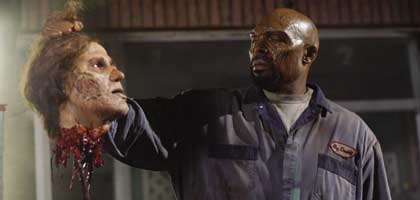
Land of the Dead
USA/Canada/France 2005

Reviewed by Kim Newman
Synopsis
Our synopses give away the plot in full, including surprise twists.
America, a few years after the collapse of society brought about by the rising of the dead as flesh-eating ghouls whose bite reduces the living to the same condition. Kaufman (Dennis Hopper), a tycoon, has established an enclave within a ruined city, maintaining a luxury lifestyle for his cronies inside a high-rise development called Fiddler's Green. Everyone else is left to get by in slums. Kaufman employs mercenaries to roam the outlands in Dead Reckoning, a heavily-armoured truck, to bring in supplies and cull the zombies, who can be killed by shots to the head. Riley (Simon Baker), designer of the Dead Reckoning, and his friend Charlie (Robert Joy), a slightly slow-witted sharpshooter, intend to quit Kaufman's army and head for the wilderness, while Cholo (John Leguizamo), Riley's second in command, hopes to buy his way into Fiddler's Green.
The Dead Reckoning attracts the attention of Big Daddy (Eugene Clark), an evolved zombie who is regaining his intelligence, and the vengeful creature leads a horde of the dead towards the city. When Kaufman refuses Cholo a place in Fiddler's Green, the latter steals Dead Reckoning and threatens to use the vehicle's armaments to launch a strike against the building unless he's paid off. Kaufman has to ask Riley, whom he has previously had jailed, to prevent this. Riley sets out on his mission with Charlie, ex-hooker Slack and some of Kaufman's soldiers. Big Daddy's army attacks the city, even invading Fiddler's Green. Riley and his crew take the Dead Reckoning back from Cholo, who is bitten and infected. Kaufman tries to evacuate, but is attacked by Big Daddy and then the zombie Cholo. Kaufman and Cholo are burned to death. Riley returns to the city and helps save the remaining population - but lets Big Daddy survive and wander off. The Dead Reckoning leaves the city and heads north.
Review
In Land of the Dead George A Romero returns to territory the director can claim to own, but which has been usurped by many others. With Night of the Living Dead (1968), Romero redefined the American horror film. His instant imitators noticed the extreme gore, the downbeat plotting and the suspense mechanics, but usually missed the social comment and the edgy, uncomfortable characterisation. With Dawn of the Dead (1978), the splatter and the satire became more explicit, but post-hippy regret for lost opportunities for change added a wistful melancholia. And Day of the Dead (1985) was at once more despairing about living humanity and more open to the possibility that the dead might have something useful to contribute.
Every time Romero has returned to the world of Night of the Living Dead, he has delivered a sequel but also a reboot - each film seems to reflect the years in which it was made. Night was informed by Vietnam and the civil rights movement; Dawn by materialism and the increasing social divide; Day by militarism and the bleak underside of Reaganomics. While Romero has been away from his signature series because of career reversals - since The Dark Half (1993), he has directed only one film, the little-seen Bruiser (2000) - there's also a sense he might have been waiting for America to become terrible again, in a sufficiently different way to need a new Dead picture.
Drawing on elements from an ambitious Day of the Dead script he abandoned in the early 1980s, Land of the Dead is, nevertheless, a cartoon of Bush II-era cruel America, with the evocatively named tower-block mall Fiddler's Green surrounded by shantytowns and bars where tourists can bet on cage matches between the hungry dead. There are socially incisive details throughout. At one point, for instance, aspiring Fiddler's Green resident Cholo brings the tower's tycoon owner Kaufman bottles of scavenged champagne in an attempt to buy his way into (to quote The Omega Man) "this honky paradise". He pours two measures in whisky glasses, and Kaufman only has to decant his into the proper flute to put the Hispanic outsider in his place before decreeing that he has no further use for him. Later, when bitten by a zombie, Cholo refuses a friend's offer to despatch him execution-style, which is the usual treatment for still-living infectees. "You know I always wanted to see how the other half lives," says the middleman, now acutely aware of his place in the social order and that if he cannot enter the penthouse he might as well join the hordes in the graveyards.
Paradoxically, this is the most hopeful film in the series, in that it presents a genuine movie-style hero in Simon Baker's handsome and compassionate Riley, as well as Asia Argento's all-purpose action heroine. Romero's drop-out heroes, rebel outlaws or desperate survivalists always constitute 1968-like rainbow alliances, a connection made most explicit in the jousting bikers of Knightriders (1981). One thread that carries through the Living Dead films is the depiction of black men as repositories of sense who are victimised by a bigoted America, from Duane Jones shot through the head by the posse in Night and Ken Foree's Swat team leader in Dawn to Terry Alexander's Jamaican slacker in Day. With Baker the whitest imaginable lead, this role is taken in Land of the Dead by Eugene Clark's Big Daddy, the zombie who - picking up on an evolutionary process that has developed by increments over the series - is on the point of regaining real intelligence, overcoming the dead's tendency to repeat meaningless tasks parodic of their former lives.
It's ironic that Romero's return to zombie territory was made commercially possible by the success of the Dawn remake and the sincere, surprisingly smart parody Shaun of the Dead - not to mention the co-opting of the director's strategies in the computer game Resident Evil. There was a risk that such a return would show him respected but less in tune with the way things are now done. There is some use of new effects techniques, and individual zombie make-ups are more elaborate than before. But we're back to the slow-moving dead, who mostly seem a nuisance rather than truly dangerous but devour with bloody ferocity. The 'gags' that are so much a part of the series recur (a belly ring is shown being ripped out), though the necessity to secure an R rating in the US means that this aspect is less prominent than in the last two unrated sequels.
As always in Romero's films, the zombie threat is the backdrop rather than the whole story, which here boils down to an argument over how a society with limited resources should be run. But the dead press in when the living abdicate responsibility. All the sequels end with survivors moving on in search of a better place, but without much hope. In this film, in a sole mellow touch, there's a sense that some justice has been done in that the devoured have mostly been villains. The good guys seem to have faith that there is at least a probability of a utopian refuge away from the corruptions of civilisation and even a possible détente with the dead.
Credits
- Director
- George A. Romero
- With
- Simon Baker
- John Leguizamo
- Dennis Hopper
- Asia Argento
- Certificate
- 15
- Running Time
- 92m 58s
